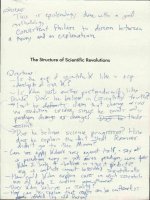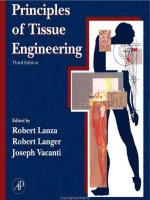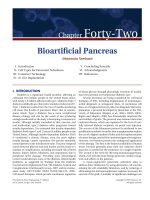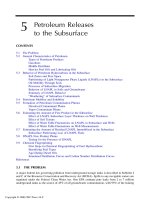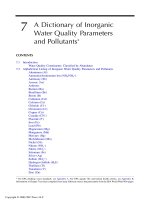Principles of environmental chemistry 3rd ed james e girard (jones bartlett learning, 2014)
Bạn đang xem bản rút gọn của tài liệu. Xem và tải ngay bản đầy đủ của tài liệu tại đây (22.22 MB, 871 trang )
PRINCIPLES OF
ENVIRONMENTAL
CHEMISTRY
Jones & Bartlett Learning Titles in Physical Science
Astronomy Activity and Laboratory Manual
Alan W. Hirshfeld
Climatology, Second Edition
Robert V. Rohli & Anthony J. Vega
Earth’s Natural Resources
John V. Walther
Environmental Oceanography: Topics and Analysis
Daniel C. Abel & Robert L. McConnell
Environmental Science, Ninth Edition
Daniel D. Chiras
Environmental Science: Systems and Solutions, Fifth Edition
Michael L. McKinney, Robert M. Schoch, & Logan Yonavjak
Essential Invitation to Oceanography
Paul R. Pinet
Essentials of Geochemistry, Second Edition
John V. Walther
Igneous Petrology, Third Edition
Alexander McBirney
In Quest of the Universe, Seventh Edition
Theo Koupelis
Invitation to Oceanography, Sixth Edition
Paul R. Pinet
Louisiana Weather and Climate
Robert V. Rohli, John M. Grymes III, & Anthony J. Vega
Meteorology: Understanding the Atmosphere, Third Edition
Steven A. Ackerman & John A. Knox
Principles of Atmospheric Science
John E. Frederick
Restoration Ecology
Sigurdur Greipsson
World Headquarters
Jones & Bartlett Learning
5 Wall Street
Burlington, MA 01803
978-443-5000
www.jblearning.com
Jones & Bartlett Learning books and products are available through most bookstores and online booksellers. To contact Jones & Bartlett
Learning directly, call 800-832-0034, fax 978-443-8000, or visit our website, www.jblearning.com.
Substantial discounts on bulk quantities of Jones & Bartlett Learning publications are available to corporations, professional
associations, and other qualified organizations. For details and specific discount information, contact the special sales department at
Jones & Bartlett Learning via the above contact information or send an email to
Copyright © 2014 by Jones & Bartlett Learning, LLC, an Ascend Learning Company
All rights reserved. No part of the material protected by this copyright may be reproduced or utilized in any form, electronic or
mechanical, including photocopying, recording, or by any information storage and retrieval system, without written permission from the
copyright owner.
Principles of Environmental Chemistry, Third Edition is an independent publication and has not been authorized, sponsored, or
otherwise approved by the owners of the trademarks or service marks referenced in this product.
Some images in this book feature models. These models do not necessarily endorse, represent, or participate in the activities represented
in the images.
Production Credits
Chief Executive Officer: Ty Field
President: James Homer
SVP, Editor-in-Chief: Michael Johnson
SVP, Chief Marketing Officer: Alison M. Pendergast
Executive Publisher: Kevin Sullivan
Senior Acquisitions Editor: Erin O’Connor
Editorial Assistant: Michelle Bradbury
Production Editor: Leah Corrigan
Senior Marketing Manager: Andrea DeFronzo
V.P., Manufacturing and Inventory Control: Therese Connell
Composition: CAE Solutions Corp.
Cover Design: Michael O’Donnell
Rights & Photo Research Associate: Lauren Miller
Cover Image: © Pichugin Dmitry/ShutterStock, Inc.
Printing and Binding: Edwards Brothers Malloy
Cover Printing: Edwards Brothers Malloy
To order this product, use ISBN 978-1-4496-9352-7
Library of Congress Cataloging-in-Publication Data
Girard, James.
Principles of environmental chemistry / James Girard.—3rd ed.
p. cm.
ISBN 978-1-4496-5015-5 (alk. paper)
1. Environmental chemistry. I. Title.
QD33.2.G57 2013
628.501'54—dc23
2012021748
6048
Printed in the United States of America
17 16 15 14 13 10 9 8 7 6 5 4 3 2 1
Dedicated to my wife, Connie Diamant, the real environmentalist in our home.
Image © Vividfour/ShutterStock, Inc.
BRIEF CONTENTS
CHAPTER
1
Planet Earth: Rocks, Life, and Energy
CHAPTER
2
Earth’s Soil and Agriculture: Feeding the Earth’s People
CHAPTER
3
The Earth’s Atmosphere
CHAPTER
4
Global Warming and Climate Change
CHAPTER
5
Chemistry of the Troposphere
CHAPTER
6
Chemistry of the Stratosphere
CHAPTER
7
Analysis of Air and Air Pollutants
CHAPTER
8
Water Resources
CHAPTER
9
Water Pollution and Water Treatment
CHAPTER
10
Analysis of Water and Wastewater
CHAPTER
11
Fossil Fuels: Our Major Source of Energy
CHAPTER
12
Nuclear Power
CHAPTER
13
Energy Sources for the Future
CHAPTER
14
Inorganic Metals in the Environment
CHAPTER
15
Organic Chemicals in the Environment
CHAPTER
16
Sustainability and Green Chemistry
CHAPTER
17
Insecticides, Herbicides, and Insect Control
CHAPTER
18
Toxicology
CHAPTER
19
Asbestos
CHAPTER
20
The Disposal of Dangerous Wastes
APPENDIX A
Solubility Products, Ksp
APPENDIX B
Dissociation Constants for Acids and Bases in Aqueous Solution at 25°C
APPENDIX C
Standard Redox Potentials in Aqueous Solutions
APPENDIX D
Carbon Compounds: An Introduction to Organic Chemistry
APPENDIX E
Answers to Even-Numbered Questions
GLOSSARY
INDEX
Image © Vividfour/ShutterStock, Inc.
CONTENTS
PREFACE
ACKNOWLEDGMENTS
CHAPTER 1
Planet Earth: Rocks, Life, and Energy
The Formation of the Universe
Galaxies and Stars
The Planets in Our Solar System
The Sun
Differentiation of the Earth into Layers
Heating of the Earth
The Core
The Mantle
The Crust
Plate Tectonics
Relative Abundance of the Elements in the Earth
Formation of the Oceans
Formation of the Atmosphere
Rocks and Minerals
The Rock Cycle
Igneous Rocks
Sedimentary Rocks
Metamorphic Rocks
Rocks as Natural Resources
Ores and Metals
Iron
Aluminum
Copper
Strategic Metals
Mineral Reserves
The Origin of Life on Earth
The Uniqueness of the Earth
The Environment
Ecosystems
Producers and Consumers
The Flow of Energy Through Ecosystems
What Is Energy?
Energy Transformations
Food Chains and Trophic Levels
Energy and Biomass
Concentration Units
Molarity and Molar Solutions
Parts per Million
Parts per Billion
Nutrient Cycles
The Carbon Cycle
The Nitrogen Cycle
The Oxygen Cycle
The Phosphorus Cycle
Nature’s Cycles in Balance
Additional Sources of Information
Keywords
Questions and Problems
CHAPTER 2
Earth’s Soil and Agriculture: Feeding the Earth’s People
Population Growth
Population Arithmetic
The Development of Modern Agriculture
Soil
Soil Texture
The Inorganic Component
Humus: The Organic Component
Soil pH
Soil Erosion
Plant Nutrients
Nitrogen
Anhydrous Ammonia
Ammonium Salts
Urea
Phosphorus
Potassium
Secondary Nutrients: Calcium, Magnesium, and Sulfur
Micronutrients
Mixed Fertilizers
The Use of Synthetic Inorganic Fertilizers
Organic Fertilizers
Composting
New Varieties of Crop Plants
Can We Feed Tomorrow’s World?
Additional Sources of Information
Keywords
Questions and Problems
CHAPTER 3
The Earth’s Atmosphere
The Major Layers in the Atmosphere
Temperature Changes in the Atmosphere
Pressure and Density Changes in the Atmosphere
Composition of the Atmosphere
Units Used to Describe Atmospheric Chemistry
Parts per Million, Parts per Billion, and Parts per Trillion
Molecules per Cubic Centimeter
Micrograms per Cubic Meter
Energy Balance
Electromagnetic Radiation
The Earth’s Heat Balance
Particles in the Atmosphere
Suspended Particulate Matter
Aerosol Particles
Anthropogenic Sources of Particulate Matter
Residence Times of Particles
Control of Particulate Emissions
Additional Sources of Information
Keywords
Questions and Problems
CHAPTER 4
Global Warming and Climate Change
Global Temperature from the Ice Ages to Present Time
The Increase in Atmospheric Carbon Dioxide
Infrared Absorption and Molecular Vibrations
Residence Time of Atmospheric Gases
Atmospheric Water Vapor
Atmospheric Carbon Dioxide
Atmospheric Methane
Atmospheric Nitrous Oxide
Atmospheric Chlorofluorocarbons
Radioactive Forcing
Radiative Forcing Caused by Human Activity
Radiative Forcing Caused by Nature
Evidence for Global Warming
Effects of Global Warming
Slowing Global Warming
Additional Sources of Information
Keywords
Questions and Problems
CHAPTER 5
Chemistry of the Troposphere
Chemical Reactions in the Atmosphere
Carbon Monoxide
Sources of CO
Effects of CO on Human Health
Nitrogen Oxides
Sources of NOx
Fate of Atmospheric NOx
Effects of NOx on Human Health and the Environment
Volatile Organic Compounds
Automobile Four-Cycle Internal Combustion Engine
Gasoline Powered Two-Cycle Engines
Automobile Pollutants and the Catalytic Converter
Diesel Trucks
Sulfur Dioxide
Sources of SO2
Fate of Atmospheric SO2: Acid Rain
Effects of SO2 on Human Health and the Environment
Methods for Controlling Emissions of SO2
Legislation to Control Emissions of SO2
Industrial Smog
Photochemical Smog
Production of Hydroxyl Radicals
Reactions of Hydroxyl Radicals with Hydrocarbons
Abstraction of Hydrogen
Addition to Double Bonds
Secondary Smog-Forming Reactions
Ozone: A Pollutant in the Troposphere
Temperature Inversions and Smog
Regulating Air Pollution
Indoor Air Pollution
Additional Sources of Information
Keywords
Questions and Problems
CHAPTER 6
Chemistry of the Stratosphere
Dobson Unit
The Production of Ozone in the Stratosphere
Determining the Steady-State Concentration of Ozone
Catalytic Destruction of Ozone
Hydroxyl Radical Cycle
Nitric Oxide Cycle
Chlorine Cycle
Null Cycles
Depletion of the Protective Ozone Layer in the Stratosphere
Effects of Ozone Depletion on Human Health and the Environment
Ozone Loss over the Arctic and the Middle to High Latitudes
The Montreal Protocol
Alternatives to Chlorofluorocarbons
Additional Sources of Information
Keywords
Questions and Problems
CHAPTER 7
Analysis of Air and Air Pollutants
In Situ Absorption Measurements
In Situ Ozone Measurements
In Situ Carbon Dioxide Measurements
Infrared Spectrometry
Infrared Vibrational Frequencies
Remote Measurements of Atmospheric Composition
Atmospheric Trace Molecular Spectroscopy
Limb Infrared Monitor of the Stratosphere
Total Ozone Mapping Spectrometer
Light Detection and Ranging
Monitoring Automotive Emissions
Automobile Emissions: Hydrocarbons
Automobile Emissions: Nitrogen Oxides
Automobile Emissions: Carbon Monoxide
Sample Handling
Monitoring Emissions from Stationary Sources
Monitoring SO2 Emissions
Pararosaniline Spectrophotometric Method for the Determination of SO2
Particulate Emissions
Fossil Fuel Combustion
Industrial Sources
Miscellaneous Sources
Monitoring Particulate Emissions
High-Volume Sampling
Separation of Particles by Size
XRF Spectrometry
Fly Ash
Additional Sources of Information
Keywords
Questions and Problems
CHAPTER 8
Water Resources
Distribution of Water on the Earth
The Composition of Natural Waters
The Hydrologic Cycle: Recycling and Purification
The Unique Properties of Water
The Water Molecule and Hydrogen Bonding
Boiling Point and Melting Point
Heat Capacity
Heat of Fusion and Heat of Vaporization
Temperature–Density Relationship
Acid–Base Properties
Carbon Dioxide in Water
Alkalinity
Acid Rain
The Effects of Acid Rain
The Causes of Acid Rain
Acid Mine Drainage
Water Use and Water Shortages
Water Management and Conservation
Water Transfer
Conservation
Potable Water from Wastewater
Desalination
Water Withdrawal, Water Consumption, and Water Pollution
Water as a Limiting Resource for Economic Growth
The Limits of Water Consumption
Water Consumption and Economic Growth
Additional Sources of Information
Keywords
Questions and Problems
CHAPTER 9
Water Pollution and Water Treatment
Types of Water Pollutants
Point and Nonpoint Sources of Water Pollutants
Disease-Causing Agents
Oxygen-Consuming Wastes
Plant Nutrients
Nitrogen
Anhydrous Ammonia
Ammonium Salts
Urea
Phosphorus
Potassium
Secondary Nutrients: Calcium, Magnesium, and Sulfur
Micronutrients
Mixed Fertilizers
The Use of Synthetic Inorganic Fertilizers
Plant Nutrients and Eutrophication
Control of Eutrophication
Anaerobic Decomposition of Organic Material
Oxidation–Reduction Reactions in Aqueous Systems
Electron Activity and pE
Measurement of pE
Suspended Solids and Sediments
Dissolved Solids
Thermal Pollution
Pollution of Groundwater
Sewage Treatment
Primary Treatment
Secondary Treatment
Disinfection with Chlorine
Tertiary Treatment
Regulation of Water Quality
Rivers and Lakes
Drinking Water
Emerging Contaminants
Releases of Pharmaceuticals to Our Waterways
Control Methods
Additional Sources of Information
Keywords
Questions and Problems
CHAPTER 10 Analysis of Water and Wastewater
Sampling Methods
Types of Water Pollutants
Disease-Causing Agents
Microbiological Tests for Coliform
Multiple-Tube Fermentation Technique
Membrane Filtration Technique
Ortho-nitrophenyl-β-D-galactopyranoside Test
Oxygen-Consuming Wastes
Dissolved Oxygen
Total Organic Carbon
Biological Oxygen Demand
Colorimetric Methods
UV-Visible Spectrometer
Plant Nutrients
Spectrophotometric Determination of Phosphorus
Spectrophotometric Determination of Nitrogen
Dissolved Solids
Conductivity Measurements
Electrochemical Sensors
Glass pH Electrode
Ca2+-Sensing Ion-Selective Electrode
Alkalinity
Measuring Acidity of Natural Waters
Measuring Alkalinity of Natural Waters
Comparing Acidity, Alkalinity, and Hardness
Ion Chromatography
Ion Exchange
Ion Chromatography Instrument
Separation and Detection of Anions by Ion Chromatography
Radioactive Substances
Additional Sources of Information
Keywords
Questions and Problems
CHAPTER 11 Fossil Fuels: Our Major Source of Energy
Energy Use: A Historical Overview
Current Use of Energy
Energy and Power
Energy from Fuels
Petroleum
The Formation of Oil Fields
Deep-Sea Oil Platforms
Jack-up Rigs
Tension Leg Platforms
Spar Platforms
Semi-submersible Platforms
Future Deep-Sea Drilling
The Composition of Petroleum
Petroleum Refining
Octane Rating
Oil Shale and Tar Sands
Keystone
Keystone XL
The Petrochemical Industry
Oil Pollution
Natural Gas
Induced Hydraulic Fracturing
Environmental Problems Caused by Fracking
Can Fracking Cause Earthquakes?
Safe Drinking Water Act Exemption
Coal
The Formation of Coal Deposits
The Composition of Coal
Problems with Coal
Coal Gasification
Coal Liquefaction
Electricity
Sequestering CO2
Additional Sources of Information
Keywords
Questions and Problems
CHAPTER 12 Nuclear Power
The Nature of Natural Radioactivity
Penetrating Power and Speed of the Types of Radiation
Nuclear Stability
Nuclear Reactions
Radioactive Decay Series
The Half-Life of Radioisotopes
The Harmful Effects of Radiation on Humans
Why Is Radiation Harmful?
Factors Influencing Radiation Damage
Detection of Radiation
Units of Radiation
How Much Radiation Is Harmful?
Everyday Exposure to Radiation
Natural Sources of Radiation
Radiation from Human Activities
Uses of Radioisotopes
Determining the Dates of Archeological and Geological Events
Nuclear Fission
The Energy Source in Nuclear Fission
Fission Reactions
The Atomic Bomb
Peaceful Uses of Nuclear Fission
Nuclear Energy
Nuclear Fission Reactors
The Nuclear Fuel Cycle
Problems with Nuclear Energy
Fukushima Daiichi Nuclear Disaster
Thorium Reactor: Thorium Fuel Cycle
Liquid Fluoride Thorium Reactor
Thorium Reactor Waste
Nuclear Breeder Reactors
Nuclear Fusion
Additional Sources of Information
Keywords
Questions and Problems
CHAPTER 13 Energy Sources for the Future
Energy-Efficient Lighting
Solar Energy
Solar Heating for Homes and Other Buildings
Electricity from Solar Thermal Power Collectors
Electricity from Photovoltaic Cells
Energy from Biomass
Burning Biomass
Production of Biogas
Biofuels
Corn Ethanol
Cellulosic Ethanol
Biodiesel
Triglycerides
Wind Power
Geothermal Energy
Water Power
Tidal Power
Energy from Hydrogen Gas
Fuel Cells*
Polymer Electrolyte Membrane Fuel Cell
Phosphoric Acid Fuel Cell
Direct Methanol Fuel Cell
Alkaline Fuel Cell
Molten Carbonate Fuel Cell
Solid Oxide Fuel Cell
Regenerative (Reversible) Fuel Cell
Clean Cars for the Future
Energy Sources for the Twenty-First Century
Additional Sources of Information
Keywords
Questions and Problems
CHAPTER 14 Inorganic Metals in the Environment
Bioaccumulation of Heavy Metals
Toxic Metals
Atomic Spectroscopy
Flame Atomic Absorption Spectroscopy
Lead
X-Ray Fluorescence
Graphite Furnace Atomic Absorption Spectrometry
Mercury
Cold-Vapor Atomic Absorption Determination of Mercury
Cadmium
Inductively Coupled Plasma Optical Emission Spectroscopy
Arsenic
AA Hydride Method for Arsenic
Additional Sources of Information
Keywords
Questions and Problems
CHAPTER 15 Organic Chemicals in the Environment
Polychlorinated Hydrocarbons
DDT
Dioxin
PCBs
Persistent, Bioaccumulative, and Toxic Pollutants
Octanol/Water Partition Coefficient
Sorption on Soils
Carbon-Normalized Sorption Coefficient
Experimentally Measuring Absorption
Henry’s Law
Using the EPA’s PBT Profiler
Persistence
Bioconcentration
Toxicity
Analysis of Persistent Organic Pollutants in Environmental Samples
Gas Chromatography
Analysis of PCBs and PAHs by Gas Chromatography–Mass Spectrometry
Mass Spectrometry
Gas Chromatography–Mass Spectrometry
Analysis of Dioxins and Furans by Gas Chromatography–Mass Spectrometry
References
Additional Sources of Information
Keywords
Questions and Problems
CHAPTER 16 Sustainability and Green Chemistry
Sustainable Consumption and Production
Five Axioms of Sustainability
Axiom 1. Any Society that Continues to Use Critical Resources Unsustainably Will Collapse
Axiom 2. Population Growth and/or Growth in the Rates of Consumption of Resources Cannot Be Sustained
Axiom 3. To Be Sustainable, the Use of Renewable Resources Must Proceed at a Rate that Is Less Than or Equal to the Rate of
Natural Replenishment
Axiom 4. To Be Sustainable, the Use of Nonrenewable Resources Must Proceed at a Rate that Is Declining, and the Rate of
Decline Must Be Greater Than or Equal to the Rate of Depletion
Axiom 5. Sustainability Requires that Substances Introduced into the Environment from Human Activities Be Minimized and
Rendered Harmless to Biosphere Functions
United Nations Commission on Sustainable Development
Decoupling
UN International Resource Panel
Life-Cycle Thinking
Life-Cycle Assessment
Product Life-Cycle Mapping
Identifying Inputs and Outputs
Design Checklist
Engage Suppliers
Leapfrog Technology
Sustainability and Chemistry
Green Chemistry
Green Chemistry Examples
Greener Solvents
Earth-Friendly Plastics
Replacing Chlorine
Replacing Toxic Metals
Environmentally Benign Pesticides
Atom Economy
Putting Sustainability into Practice
References
Additional Sources of Information
Keywords
Questions and Problems
CHAPTER 17 Insecticides, Herbicides, and Insect Control
Organophosphates
Carbamates
The Transmission of Nerve Impulses
Analysis of Organophosphate Insecticides in Water
Gas Chromatography Using a Flame Photometric Detector
Herbicides
High-Pressure Liquid Chromatography
Problems with Synthetic Pesticides
The Pesticide Treadmill
Health Problems
Alternative Methods of Insect Control
Chemical Communicating Substances
Pheromones
Sex Pheromones
Aggregation and Trail Pheromones
Juvenile Hormones
Allomones
Biological Controls
Sterilization
Future Farming: Less Reliance on Agricultural Chemicals
New Varieties of Crop Plants
Can We Feed Tomorrow’s World?
Additional Sources of Information
Keywords
Questions and Problems
CHAPTER 18 Toxicology
What Is Meant by “Toxic”?
Types and Routes of Exposure
Routes of Administration
Percutaneous
Inhalation
Oral
Parenteral
Dose and Response
Testing for Toxicity: The LD50 Test
Excretion of Chemicals from the Body
Detoxification of Chemicals by the Liver
Oxidation–Reduction Reactions
Coupling Reactions
Teratogens, Mutagens, and Carcinogens
Teratogens
Mutagens
Carcinogens
Chemicals That Cause Cancer
The Development of Cancer
Nucleic Acids
Functions of Nucleic Acids
The Primary Structure of Nucleic Acids
The Double Helix
DNA, Genes, and Chromosomes
Cell Replication
Protein Synthesis
The Genetic Code
Mechanisms of DNA Damage
Ionizing Radiation
Ultraviolet Light
Chemicals
Alkylation of DNA
Ames Test
Genetic Tests for Cancer
Additional Sources of Information
Keywords
Questions and Problems
CHAPTER 19 Asbestos
Silicates
Three-Dimensional Networks and Sheets
Long-Chain Silicates: Asbestos
Amphiboles
Serpentines: Chrysotile
Physical Properties of Asbestos Minerals
Thermal Properties of Asbestos
Chemical Resistance of Asbestos
Asbestos Diseases
The Respiratory System’s Protective Mechanisms
Fiber Drift
Regulation of Asbestos
Analytical Methods for Asbestos Fibers
Methods to Identify the Presence of Bulk Asbestos
Light Microscopy
Polarized Light Microscopy
Methods to Determine the Amount of Airborne Asbestos
Air Sampling
Phase Contrast Microscopy
Transmission Electron Microscopy
Energy-Dispersive X-Ray Spectroscopy
Comparing PCM and TEM Measurements
Asbestos Litigation
Additional Sources of Information
Keywords
Questions and Problems
CHAPTER 20 The Disposal of Dangerous Wastes
Careless Waste Disposal in the Past
Defining Solid Waste
Disposal of Municipal Solid Waste
MSW and the Law
Landfills
Incineration
Recycling and Resource Recovery
Source Reduction
The Problem of Hazardous Waste
RCRA: Regulation of Hazardous Waste
What Are Hazardous Wastes?
Listed Hazardous Wastes
Characteristic Hazardous Wastes
Sources of Hazardous Waste
Policy for Management and Disposal of Hazardous Waste
Waste Minimization: Process Manipulation, Recycling, and Reuse
Conversion of Hazardous Waste to a Less Hazardous or Nonhazardous Form
Incineration and Other Thermal Treatment
Chemical and Physical Treatment
Bioremediation
Perpetual Storage of Hazardous Waste
Secured Landfill
Deep-Well Injection
Surface Impoundment
EPA Methods for Testing Solid Waste
The Unsolved Problem
Superfund: Cleaning Hazardous Waste Dumpsites
Superfund Analytical Methods
Radioactive Waste
Sources of Radioactive Waste
Classification of Nuclear Waste
The Legacy from the Past
Regulation of Radioactive Waste Disposal
Low-Level Radioactive Wastes
High-Level Radioactive Wastes
Technologies for Radioactive Waste Disposal
The Post–Cold War Challenge
Additional Sources of Information
Keywords
Questions and Problems
APPENDIX A.
APPENDIX B.
APPENDIX C.
APPENDIX D.
APPENDIX E.
Glossary
Index
Solubility Products, Ksp
Dissociation Constants for Acids and Bases in Aqueous Solution at 25°C
Standard Redox Potentials in Aqueous Solutions
Carbon Compounds: An Introduction to Organic Chemistry
Answers to Even-Numbered Questions
Image © Vividfour/ShutterStock, Inc.
PREFACE
Principles of Environmental Chemistry, Third Edition has been revised and updated in response to
comments and suggestions from reviewers and users of the second edition. All chapters have been
updated to highlight events and initiatives that have transpired since the last edition, such as:
1. The tsunami in Japan, its causes and effects on Japanese nuclear power industry
2. Deep ocean drilling for oil and the effects of a disaster such as the Deepwater Horizon blowout
in the Gulf of Mexico
3. How to reduce soot in diesel truck emissions to meet new regulations
4. Changing the relationship between water use and economic growth in developing countries
5. Canadian tar sands and the Keystone XL pipeline
6. Induced hydraulic fracturing (fracking) and the production of natural gas
7. The future of the thorium nuclear reactor
8. Biofuels—ethanol from cellulose
9. The introduction of lifecycle assessments
10. Resource decoupling and the development of the third world
Users of the second edition lamented the loss of the chapter on soil and agriculture (Chapter 2) that
was in the first edition, but removed from the second edition. They will be happy to learn that an
updated chapter on soil and agriculture (Chapter 2) makes its return to the third edition.
In response to reviewer’s preferences, a new chapter on sustainability and green chemistry has
been included. I spent my last sabbatical leave as a Franklin Fellow in the U.S. Department of State.
While there, I coordinated the U.S.’s report to the United Nations Commission on Sustainable
Development (UNCSD). The CSD-18 report, which focused on U.S. initiatives in chemicals, mining,
transport, waste management, and sustainable consumption and production, can be found at
During my time at the Department of
State, I was also fortunate to be appointed the U.S. representative to the UN’s International Resource
Panel. I am pleased that I can share what I learned about sustainability with students using this text. I
also want to thank Professor Jonathan Kenny of Tufts University for his review of this new chapter.
I am happy to receive comments and suggestions about the content of this book at
Chapter Elements
Examples and Exercises Illustrative worked examples, each one accompanied by a challenging
practice exercise, are included throughout the text, particularly in the chapters covering basic
chemical principles.
Keywords and Concepts Lists of keywords and concepts introduced in the chapter are included at
chapter’s end to help reinforce the most important information.
Questions and Problems Each chapter includes a wide selection of problems and questions (40–50),
with answers to all even-numbered ones given in Appendix E. Quantitative, review, and discussiontype questions are included.
Additional Sources of Information A bibliography provides sources for the material covered in the
chapter and serves as a suggested list for further reading.
Course Use
Principles of Environmental Chemistry offers the flexibility to tailor a course to suit both
instructors’ preferences and the needs of particular audiences. The full text may be used for a
comprehensive two-semester course in which the instructor has the time to explore the underlying
chemical principles in detail. Appendix B contains a chapter on basic organic chemistry, which may
be useful to cover early in the course to refresh the memory of your students. A review of basic
chemistry principles is also available online through the Navigate Companion Website.
The book may be used in several ways for a one-semester course. An option for a one-semester
course is to use the first eight chapters, followed by selections from the remaining chapters on more
advanced chemistry and environmental applications according to the teacher’s preferences. Those
who wish to teach a more traditional one-semester course, not emphasizing environmental analysis,
should begin with Chapter 1 and proceed through the first 13 chapters in order, skipping Chapters 7
and 10, and then cover more in-depth environmental topics in the later chapters according to
preference.
Instructors’ Supplements
These supplements can be accessed online, via the Jones & Bartlett Learning catalog page.
Online Solutions Manual Contains solutions to chapter-end exercises.
Image Bank Provides a PowerPoint® library of all the art and tables in the text to which Jones &
Bartlett Learning owns the copyright or has digital print rights.
PowerPoint Lecture Outlines Provides PowerPoint® presentations for each chapter of the text
including lecture notes and images.
Student’s Supplements
Navigate Companion Website Contains a wealth of information and resources for students studying
environmental chemistry, including downloadable study resources on solving problems and equations
and the basics of chemistry in addition to glossary terms, crossword puzzles, and flashcards.
Image © Vividfour/ShutterStock, Inc.
ACKNOWLEDGMENTS
I would like to express my gratitude and appreciation to a number of people who have contributed to
this book:
To my students who have suffered through draft manuscripts of this text.
To the reviewers of the text for their helpful comments and suggestions:
Andrew Burns, Kent State University Stark
Brent L. Lewis, Coastal Carolina University
Brian G. Dixon, Massachusetts Maritime Academy
Brian Nowak-Thompson, Cornell College
Chunlong Zhang, University of Houston–Clear Lake
David P. Thomas, Washtenaw Community College
Liping Wei, New Jersey Institute of Technology
Marie de Angelis, SUNY Maritime College
Matthew Elrod, Oberlin College
Michael E. Ketterer, Northern Arizona University
Michelle M. Ivey, Florida Atlantic University
Mygleetus W. Wright, Fort Valley State University
Robert Kerber, Stony Brook University
Matthew Elrod, Oberlin College
Thomas G. Chasteen, Sam Houston State University
Timothy L. Rose, Brandeis University
To Nell Buell for all the discussion and hard work with background materials.
To Bill Hirzy of the US Environmental Protection Agency who reviewed and updated the data
concerning the regulation of hazardous waste in Chapter 18.
To Ken Harvey of Horiba, Inc. who provided details of how automobile emission measurements
are made.
To Kaanan Snirvasian of Dionex Corporation who facilitated acquisition of the ion
chromatography figures.
To Wayne Neimayer at McCrone Laboratories for the SEM and EDX spectra in the asbestos
chapter.

